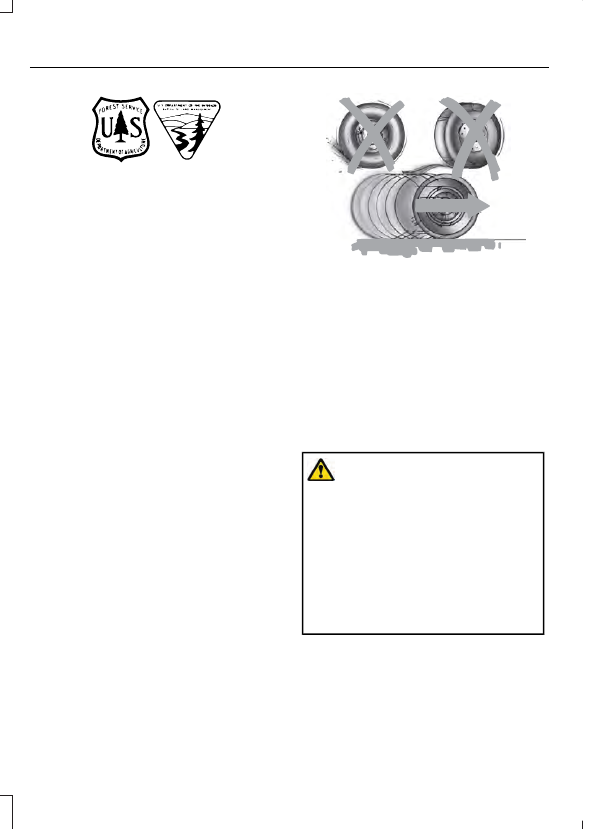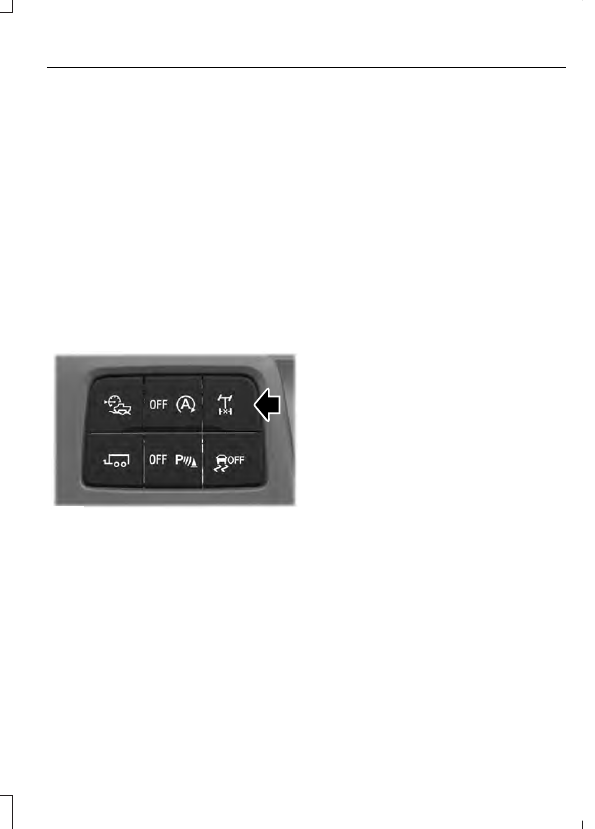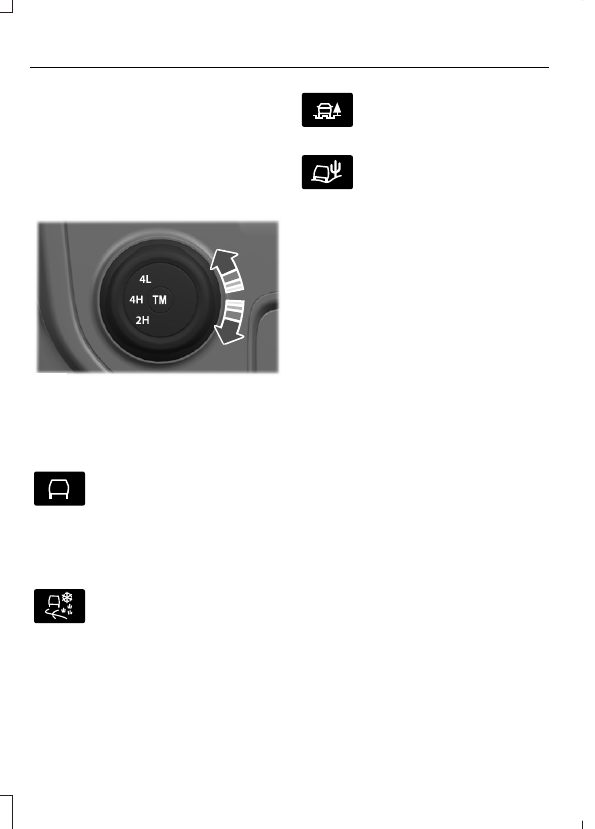Ford Ranger (2022 year). Manual in english — page 11
Maintain steering wheel control at all
times, especially in rough terrain. Since
sudden changes in terrain can result in
abrupt steering wheel motion, make sure
you grip the steering wheel from the
outside. Do not grip the spokes of the
steering wheel.
Drive cautiously to avoid vehicle damage
from concealed objects such as rocks and
stumps.
Either know the terrain or examine maps
of the area before driving. Map out your
route before driving in the area. To
maintain steering and braking control of
your vehicle, have all four wheels on the
ground and they need to be rolling, not
sliding or spinning.
Driving Off-Road With Truck and
Utility Vehicles
Note:
Your vehicle may have a front air
dam. Due to low ground clearance, you can
damage it when taking your vehicle off-road.
You can take the air dam off by removing
the bolts that secure it.
We design four-wheel drive vehicles for
driving on sand, snow, mud and rough
terrain and they have operating
characteristics that are somewhat
different from conventional vehicles, both
on and off the road.
The transfer case supplies power to all four
wheels. On four-wheel drive vehicles, the
transfer case allows you to select different
4WD modes when necessary. Become
thoroughly familiar with this information
before you operate your vehicle.
Four-wheel drive uses all four wheels to
power your vehicle. This increases traction,
enabling you to drive over terrain and road
conditions that a conventional two-wheel
drive vehicle cannot.
Basic Operating Principles
•
Drive slower in strong crosswinds which
can affect the normal steering
characteristics of your vehicle.
•
When driving your vehicle on surfaces
made slippery by loose sand, water,
gravel, snow or ice, proceed with care.
•
Do not use 4H or 4L on dry, hard
surfaced roads. Doing so can produce
excessive noise, increase tire wear and
could damage drive components. Use
4H or 4L modes for consistently
slippery or loose surfaces.
If Your Vehicle Leaves the Road
If your vehicle leaves the road, reduce your
vehicle speed and avoid severe braking.
When your vehicle speed decreases, ease
your vehicle back onto the road. Do not
sharply turn the steering wheel when
returning your vehicle to the road.
It may be safer to stay on the shoulder of
the road and gradually slow down before
returning to the road. You may lose control
if you do not slow down or if you too
sharply or abruptly turn the steering wheel.
It may be less risky to strike small objects,
such as freeway reflectors, with minor
damage to your vehicle rather than
attempt a sudden return to the road which
could cause your vehicle to slide sideways
out of control or roll over. Remember, your
safety and the safety of others should be
your primary concern.
Emergency Maneuvers
In an unavoidable emergency situation
where you must make a sudden sharp turn,
remember to avoid over-driving your
vehicle and turn the steering wheel only as
rapidly and as far as required to avoid the
emergency. Excessive steering can result
in loss of vehicle control. Apply smooth
pressure to the accelerator pedal or brake
pedal when you require changes in vehicle
167
Four-Wheel Drive
(If Equipped)
speed. Avoid abrupt steering, acceleration
and braking. This could result in an
increased risk of vehicle roll over, loss of
vehicle control and personal injury. Use the
available road surface to bring your vehicle
to a safe direction of travel.
In the event of an emergency stop, avoid
skidding the tires and do not attempt any
sharp steering wheel movements.
If your vehicle goes from one type of
surface to another, such as concrete to
gravel, there can be a change in the way
your vehicle responds to a maneuver using
steering, acceleration or braking.
Operating Four-Wheel Drive with a
Spare or Mismatched Tires
On four-wheel drive vehicles, the size of
the spare tire can affect the four-wheel
drive system. If there is a significant
difference between the size of the spare
tire and the remaining tires, you could have
limited four-wheel drive functionality,
added noise, discomfort and driveline
damage. Due to normal tire wear, your
spare tire is not necessarily the same size
as your on-road tires, which makes your
spare tire a dissimilar size. Use the spare
tire on a limited basis only. When driving
with a dissimilar wheel and tire assembly
do not:
•
Exceed 50 mph (80 km/h) with a
four-wheel drive mode turned on.
•
Turn on a four-wheel drive mode
unless the vehicle is stationary.
•
Use a four-wheel drive mode on dry
pavement.
Driving with the full-size dissimilar spare
wheel and tire assembly can limit
four-wheel drive functionality, especially
when driving in a mechanically locked
four-wheel drive mode. You can experience
the following:
•
Additional noise from the transfer case
or other drive components.
•
Difficulty shifting out of a mechanically
locked four-wheel drive mode.
•
Driveline component damage.
Mechanical Shift Blocking
On vehicles with an electronic
shift-on-the-fly transfer case, the transfer
case distributes torque to the front wheels
by mechanically interlocking the front and
rear driveshafts together. Various external
factors can affect shifting performance of
this type of system including, but not
limited to:
•
Vehicle acceleration.
•
Dissimilar tire sizes.
•
High steering input.
For vehicles with an electronic
shift-on-the-fly transfer case, when
shifting into two-wheel drive high on dry,
hard surfaced roads, we recommend that
the following procedure is followed to
reduce the likelihood of a mechanical shift
block:
•
While driving straight, come to a stop
on a flat, horizontal surface.
•
Shift into park (P).
•
Select 2H and wait for the 2H LED to
become solid.
•
Shift into reverse (R) and let the vehicle
roll backward up to 5 ft (1 m).
•
Shift into drive (D) and let the vehicle
roll forward up to 5 ft (1 m).
•
Driving the vehicle around a tight turn
at a slow speed.
If the system is mechanically blocked, one
or more of the following actions can relieve
the mechanical shift block:
•
Momentary acceleration.
•
Momentary braking.
•
Bringing the vehicle to a stop.
168
Four-Wheel Drive
(If Equipped)
•
Shifting the transmission to neutral and
back to drive.
•
Shifting the transmission to reverse
and back to drive.
•
Driving the vehicle around a tight turn
at a slow speed.
Driving in Special Conditions with
Four-Wheel Drive
Four-wheel drive vehicles are suitable for
driving on sand, snow, mud and rough
roads and have operating characteristics
that are somewhat different from
conventional vehicles, both on and off the
freeway.
When driving at slow speeds off road under
high load conditions, use a low gear when
possible. Low gear operation maximizes
the engine and transmission cooling
capability.
Basic Operating Principles
When driving your vehicle on surfaces
made slippery by loose sand, water, gravel,
snow or ice, proceed with care.
Sand
When driving over sand, try to keep all four
wheels on the most solid area of the trail.
Shift to a lower gear and drive steadily
through the terrain. Apply the accelerator
slowly and avoid excessive wheel slip.
Do not drive your vehicle in deep sand for
an extended period of time. This can cause
the system to overheat.
To resume operation, switch the ignition
off and allow the system to cool down for
a minimum of 15 minutes.
When driving at slow speeds in deep sand
under high outside temperatures, use a low
gear when possible. Low gear operation
maximizes the engine and transmission
cooling capability.
Avoid driving at excessive speeds, this
causes vehicle momentum to work against
you and your vehicle could become stuck
to the point that you could require
assistance from another vehicle.
Remember, you may be able to back out
the way you came if you proceed with
caution.
Mud and Water
Mud
Be cautious of sudden changes in vehicle
speed or direction when you are driving in
mud. Even four-wheel drive vehicles can
lose traction in slick mud. If your vehicle
does slide, steer in the direction of the slide
until you regain control of your vehicle.
After driving through mud, clean off residue
stuck to rotating driveshafts and tires.
Excess mud stuck on tires and rotating
driveshafts can cause an imbalance that
could damage drive components.
Water
If you must drive through high water, drive
slowly. Water may limit traction or brake
capability.
When driving through water, determine the
depth and avoid water higher than the
bottom of the hubs. If the ignition system
gets wet, your vehicle could stall.
Once through water, try the brakes. Wet
brakes do not stop your vehicle as
effectively as dry brakes. Drying improves
by applying light pressure to the brake
pedal when slowly moving.
Note:
Driving through deep water may
damage the transmission. If you submerge
the front or rear axle in water, have the axle
lubricant and power transfer unit lubricant
checked, and change if necessary.
169
Four-Wheel Drive
(If Equipped)

E143950
“Tread Lightly” is an educational program
designed to increase public awareness of
land-use regulations and responsibilities
in our nation's wilderness areas. We join
the U.S. Forest Service and the Bureau of
Land Management in encouraging you to
help preserve our national forest and other
public and private lands by “treading
lightly.”
Driving on Hilly or Sloping Terrain
Although natural obstacles may make it
necessary to travel diagonally up or down
a hill or steep incline, you should drive
straight up or straight down.
Note:
Avoid turning on steep slopes or hills.
A danger lies in losing traction, slipping
sideways and possible vehicle roll over. Do
not drive over the crest of a hill without
seeing what conditions are on the other side.
Do not drive in reverse over a hill without the
aid of an observer. Whenever driving on a
hill, determine beforehand the route you
intend to use.
When climbing a steep slope or hill, start
in a lower gear rather than downshifting to
a lower gear from a higher gear once the
ascent has started. This reduces strain on
the engine and the possibility of stalling.
If your vehicle stalls, do not try to turn
around because this could cause vehicle
roll over. It is better to reverse back to a
safe location.
Apply just enough power to the wheels to
climb the hill. Too much power could cause
the tires to slip, spin or lose traction,
resulting in loss of vehicle control.
E143949
Descend a hill in the same gear you would
use to climb up the hill to avoid excessive
brake application and brake overheating.
Do not descend in neutral (N). Move the
transmission selector lever to a lower gear.
When descending a steep hill, avoid
sudden hard braking as you could lose
control. Make sure the front wheels are
turning so you can steer your vehicle.
If your vehicle has anti-lock brakes, steadily
apply the brakes. Do not pump the brakes.
Driving on Snow and Ice
WARNING:
If you are driving in
slippery conditions that require tire
chains or cables, then it is critical that
you drive cautiously. Keep speeds down,
allow for longer stopping distances and
avoid aggressive steering to reduce the
chances of a loss of vehicle control
which can lead to serious injury or death.
If the rear end of your vehicle slides while
cornering, steer in the direction of the
slide until you regain control of your
vehicle.
Note:
Excessive tire slippage can cause
transmission damage
170
Four-Wheel Drive
(If Equipped)

Four-wheel drive vehicles have advantages
over two-wheel drive vehicles in snow and
ice but can skid like any other vehicle.
Should you start to slide when driving on
snowy or icy roads, turn the steering wheel
in the direction of the slide until you regain
control.
Avoid sudden applications of power and
quick changes of direction on snow and
ice. Apply the accelerator slowly and
steadily when starting from a full stop.
Avoid sudden braking. Although a
four-wheel drive vehicle may accelerate
better than a two-wheel drive vehicle in
snow and ice, it cannot stop any faster as
braking occurs at all four wheels. Do not
become overconfident of road conditions.
Make sure you allow sufficient distance
between you and other vehicles for
stopping. Drive slower than usual and
consider using one of the lower gears. In
emergency stopping situations, apply the
brake steadily. Do not pump the brake
pedal. See
If Your Vehicle Gets Stuck In Mud or
Snow
WARNING:
Do not spin the wheels
at over 34 mph (55 km/h). The tires may
fail and injure a passenger or bystander.
If your vehicle gets stuck in mud or snow,
you may rock it out by shifting between
forward and reverse gears, stopping
between shifts in a steady pattern. Press
lightly on the accelerator in each gear.
Note:
Do not rock your vehicle if the engine
is not at normal operating temperature,
damage to the transmission could occur.
Note:
Do not rock your vehicle for more
than a minute, damage to the transmission
and tires could occur or the engine could
overheat.
Parking
WARNING:
If the parking brake is
fully released, but the brake warning
lamp remains illuminated, the brakes
may not be working properly. Have your
vehicle checked as soon as possible.
WARNING:
Apply the parking
brake, shift into park (P), switch the
ignition off and remove the key before
you leave your vehicle. Failure to follow
this instruction could result in personal
injury or death.
On four-wheel drive vehicles, when the
transfer case is in the neutral (N) position,
the engine and transmission disconnect
from the rest of the driveline. Therefore,
your vehicle is free to roll even if the
automatic transmission is in park (P) or
the manual transmission is in gear. Do not
leave your vehicle unattended with the
transfer case in the neutral (N) position.
Fully set the parking brake and turn off the
ignition when leaving your vehicle.
Maintenance and Modifications
We designed and tested the suspension
and steering systems on your vehicle to
provide predictable performance whether
loaded or empty. For this reason, we
strongly recommend that you do not make
modifications such as adding or removing
parts that include lift kits or stabilizer bars,
or by using replacement parts not
equivalent to the original factory
equipment.
We recommend that you use caution when
your vehicle has either a high load or device
such as ladders or luggage racks. Any
modifications to your vehicle that raise the
center of gravity could cause your vehicle
to roll over when there is a loss of vehicle
control.
171
Four-Wheel Drive
(If Equipped)
Failure to maintain your vehicle correctly
could void the warranty, increase your
repair cost, reduce vehicle performance
and operational capabilities, and adversely
affect you and your passenger's safety. We
recommend you frequently inspect your
vehicle's chassis components when your
vehicle is subject to off road usage.
172
Four-Wheel Drive
(If Equipped)

ELECTRONIC LOCKING
DIFFERENTIAL
(IF EQUIPPED)
Note:
Do not operate the system on dry
hard surface roads. Doing so could lead to
excessive tire noise and wear. Use the
system only on consistently slippery or loose
surfaces.
The system locks the left and right portions
of the rear axle together to form a solid
driving axle, resulting in increased rear
wheel traction in certain conditions.
Press and hold the electronic differential
lock button for 2 seconds to activate the
system.
Note:
The lock button is on the center
console.
E277073
The electronic differential lock can lock
and unlock when the internal gears are
aligned and no torque load is placed on
the differential. To aid alignment, drive the
vehicle in a straight line with the
accelerator pedal released. Alternatively,
drive slowly forward and backward while
moving the steering wheel from side to side
to allow the electronic differential lock to
lock.
High vehicle speed and high accelerator
pedal application inhibit the electronic
locking differential system engagement.
Follow the instruction on the instrument
cluster for engagement and
disengagement.
Note:
You can use the system in any drive
mode 2H, 4H or 4L.
Note:
When you engage the system, the
Electronic Stability Program (ESP) functions
such as Stability Control, Traction Control,
Hill Descent Control, Emergency stop signal,
Hill Start Assist and Trailer Sway Control
are deactivated, the ESP Off indicator
illuminates, and the HDC on indicator turns
off.
Note:
When the anti-lock braking system
is operating, the system disengages.
The electronic locking differential system
can affect various terrain modes. See
Operating Electronic Locking
Differential with Spare or
Mismatched Tires
The size of the spare tire can affect the
performance of the electronic locking
differential system. When there is a
significant size difference between the two
rear tires, you could have limited electronic
locking differential functionality. If your
electronic locking differential has difficulty
disengaging, release your accelerator pedal
and turn the steering wheel in the opposite
direction while rolling forward.
Note:
We recommend that you engage and
disengage the electronic locking differential
when stopped, and a spare tire is mounted
on the rear axle.
173
Rear Axle

Electronic Locking Differential Engagement Speed and Availability
Automatic Re-
Engagement Speed
Automatic Disen-
gage Speed
Engagement Speed
Terrain Modes (4X4
Modes
20 mph (30 km/h)
25 mph (41 km/h)
20 mph (30 km/h)
Normal (2H, 4H)
20 mph (30 km/h)
25 mph (41 km/h)
20 mph (30 km/h)
grass/Gravel/Snow
(4H)
20 mph (30 km/h)
25 mph (41 km/h)
20 mph (30 km/h)
Mud/Ruts (4H)
55 mph (90 km/h)
60 mph (100 km/h)
55 mph (90 km/h)
Sand (4H)
Automatic Re-
Engagement
Speed
Automatic Disen-
gage Speed
Engagement
Speed
4X4 Modes
No set Speed
No set Speed
No set Speed
4L
174
Rear Axle

GENERAL INFORMATION
Note:
Occasional brake noise is normal. If
a metal-to-metal, continuous grinding or
continuous squeal sound is present, the
brake linings may be worn-out and an
authorized dealer should check them. If the
vehicle has continuous vibration or shudder
in the steering wheel while braking, an
authorized dealer should check your vehicle.
Note:
Brake dust may accumulate on the
wheels, even under normal driving
conditions. Some dust is inevitable as the
brakes wear and does not contribute to
brake noise. See
Wet brakes result in reduced braking
efficiency. Gently press the brake pedal a
few times when driving from a car wash or
standing water to dry the brakes.
Brake Over Accelerator
In the event the accelerator pedal
becomes stuck or entrapped, apply steady
and firm pressure to the brake pedal to
slow the vehicle and reduce engine power.
If you experience this condition, apply the
brakes and bring your vehicle to a safe
stop. Switch the engine off, move the
transmission to park (P) and apply the
parking brake. Inspect the accelerator
pedal and the area around it for any items
or debris that may be obstructing its
movement. If none are found and the
condition persists, have your vehicle towed
to the nearest authorized dealer.
Emergency Brake Assist
Emergency brake assist detects when you
brake heavily by measuring the rate at
which you press the brake pedal. It
provides maximum braking efficiency as
long as you press the pedal. Emergency
brake assist can reduce stopping distances
in critical situations.
Anti-lock Brake System
This system helps you maintain steering
control during emergency stops by keeping
the brakes from locking.
This lamp momentarily
illuminates when you switch the
ignition on. If the light does not
illuminate during start up, remains on or
flashes, the anti-lock braking system may
be disabled. Have the system checked by
an authorized dealer. If the anti-lock brake
system is disabled, normal braking is still
effective.
Note:
Indicators vary depending on region.
E270480
This lamp also illuminates
momentarily when you switch
the ignition on to confirm the
lamp is functional. If it does not
illuminate when you switch the
ignition on, or begins to flash at
any time, have the system checked by an
authorized dealer. If the brake warning
lamp illuminates with the parking brake
released, have the system checked
immediately.
HINTS ON DRIVING WITH
ANTI-LOCK BRAKES
The anti-lock brake system does not
eliminate the risks when:
•
You drive too closely to the vehicle in
front of you.
•
Your vehicle is hydroplaning.
•
You take corners too fast.
•
The road surface is poor.
175
Brakes

Note:
If the system activates, the brake
pedal could pulse and may travel further.
Maintain pressure on the brake pedal. You
may also hear a noise from the system. This
is normal.
PARKING BRAKE
WARNING:
Always fully apply the
parking brake and make sure you shift
into park (P). Switch the ignition off and
remove the key whenever you leave your
vehicle.
To apply the parking brake:
1.
Firmly press the brake pedal.
2. Pull the parking brake lever upward to
its fullest extent.
Note:
Do not press the release button when
pulling the parking brake lever upward.
Note:
If you park your vehicle on a hill and
facing uphill, shift into park (P) and turn the
steering wheel away from the curb.
Note:
If you park your vehicle on a hill and
facing downhill, shift into park (P) and turn
the steering wheel toward the curb.
To release the parking brake:
1.
Firmly press the brake pedal.
2. Slightly pull the parking brake lever
upward.
3. Press the release button and push the
parking brake lever downward.
HILL START ASSIST
WARNING:
The system does not
replace the parking brake. When you
leave your vehicle, always apply the
parking brake.
WARNING:
You must remain in
your vehicle when the system turns on.
At all times, you are responsible for
controlling your vehicle, supervising the
system and intervening, if required.
Failure to take care may result in the loss
of control of your vehicle, serious
personal injury or death.
WARNING:
The system will turn
off if a malfunction is apparent or if you
rev the engine excessively. Failure to take
care may result in the loss of control of
your vehicle, serious personal injury or
death.
The system makes it easier to pull away
when your vehicle is on a slope without the
need to use the parking brake.
When the system is active, your vehicle
remains stationary on the slope for two to
three seconds after you release the brake
pedal. This allows time to move your foot
from the brake to the accelerator pedal.
The system releases the brakes
automatically once the engine has
developed sufficient torque to prevent your
vehicle from rolling down the slope. This
is an advantage when pulling away on a
slope, for example from a car park ramp,
traffic lights or when reversing uphill into
a parking space.
The system activates on any slope that
causes your vehicle to roll.
Note:
There is no warning light to indicate
the system is either on or off.
Using Hill Start Assist
1.
Press the brake pedal to bring your
vehicle to a complete standstill. Keep
the brake pedal pressed and shift into
first gear when facing uphill or reverse
(R) when facing downhill.
176
Brakes
2. If the sensors detect that your vehicle
is on a slope, the system activates
automatically.
3. When you remove your foot from the
brake pedal, your vehicle remains on
the slope without rolling away for
about two to three seconds. This hold
time automatically extends if you are
in the process of driving off.
4. Drive off in the normal manner. The
system releases the brakes
automatically.
Note:
When you remove your foot from the
brake pedal and press the pedal again when
the system is active, you will experience
significantly reduced brake pedal travel. This
is normal.
Switching the System On and Off
Vehicles with Automatic Transmission
You cannot turn the system on or off.
When you switch the ignition on, the
system automatically turns on.
177
Brakes

PRINCIPLE OF OPERATION
The traction control system helps avoid
drive wheel spin and loss of traction.
If your vehicle begins to slide, the system
applies the brakes to individual wheels
and, when needed, reduces engine power
at the same time. If the wheels spin when
accelerating on slippery or loose surfaces,
the system reduces engine power in order
to increase traction.
USING TRACTION CONTROL
WARNING:
Operating your vehicle
with the traction control disabled could
lead to an increased risk of loss of vehicle
control, vehicle rollover, personal injury
and death.
The system automatically turns on each
time you switch the ignition on.
If your vehicle is stuck in mud or snow,
switching traction control off may be
beneficial as this allows the wheels to spin.
Note:
When you switch traction control off,
stability control remains fully active.
Switching the System Off
E166706
The switch for the stability and traction
control system is on the console.
When you switch the system off, a
message and an illuminated icon appear
on the instrument cluster.
Use the switch again to return the traction
control system to normal operation.
Your vehicle may have MyKey restrictions
regarding this feature. See
System Indicator Lights and
Messages
E138639
The stability and traction control
light temporarily illuminates on
engine start-up and flashes:
•
When a driving condition activates
either of the systems.
•
If a problem occurs in either of the
systems.
E130458
The stability and traction control
off light temporarily illuminates
on engine start-up and stays on:
•
When you switch the traction control
system off.
•
When you select an alternative stability
control mode.
178
Traction Control
PRINCIPLE OF OPERATION
WARNING:
Vehicle modifications
involving braking system, aftermarket
roof racks, suspension, steering system,
tire construction and wheel and tire size
may change the handling characteristics
of your vehicle and may adversely affect
the performance of the electronic
stability control system. In addition,
installing any stereo loudspeakers may
interfere with and adversely affect the
electronic stability control system. Install
any aftermarket stereo loudspeaker as
far as possible from the front center
console, the tunnel, and the front seats
in order to minimize the risk of interfering
with the electronic stability control
sensors. Reducing the effectiveness of
the electronic stability control system
could lead to an increased risk of loss of
vehicle control, vehicle rollover, personal
injury and death.
WARNING:
Remember that even
advanced technology cannot defy the
laws of physics. It's always possible to
lose control of a vehicle due to
inappropriate driver input for the
conditions. Aggressive driving on any
road condition can cause you to lose
control of your vehicle increasing the risk
of personal injury or property damage.
Activation of the electronic stability
control system is an indication that at
least some of the tires have exceeded
their ability to grip the road; this could
reduce the operator's ability to control
the vehicle potentially resulting in a loss
of vehicle control, vehicle rollover,
personal injury and death. If your
electronic stability control system
activates, SLOW DOWN.
The system automatically turns on each
time you switch the ignition on.
If the stability control or traction control
system detects a fault, the following may
occur:
•
The stability and traction control light
illuminates steadily.
•
The stability control and traction
control systems do not enhance your
vehicle's ability to maintain traction of
the wheels.
If the stability control or traction control
system activates, the following may occur:
•
The stability and traction control light
flashes.
•
Your vehicle slows down.
•
Reduced engine power.
•
A vibration in the brake pedal.
•
The brake pedal is stiffer than usual.
•
If the driving condition is severe and
your foot is not on the brake pedal, the
pedal may move as the system applies
higher brake force.
The stability control system has several
features built into it to help you maintain
control of your vehicle.
Electronic Stability Control
The system helps to prevent your vehicle
skidding or laterally sliding by individually
applying the brakes to one or more wheels
and, if necessary, reducing engine power.
Roll Stability Control
The system helps to prevent rollovers by
detecting your vehicle's roll motion, and
individually applying the brakes to one or
more wheels.
Traction Control
The system enhances your vehicle's ability
to maintain traction of the wheels by
detecting and controlling wheel spin. See
179
Stability Control

E72903
Vehicle without stability control
skidding off its intended route.
A
Vehicle with stability control
maintaining control on a slippery
surface.
B
USING STABILITY CONTROL
AdvanceTrac™ with Roll Stability
Control™ (RSC™)
The system automatically turns on each
time you switch the ignition on.
E277072
You can switch the electronic stability
control systems off.
When you shift the transmission into
reverse (R), the systems are disabled.
You can switch the traction control system
off or on independently. See
AdvanceTrac with RSC Features
Traction
control system
Electronic
stability
control
Roll stability
control
Stability
control OFF
light
Button func-
tions
Enabled
Enabled
Enabled
Illuminated
during bulb
check
Default at start-
up
Disabled
Enabled
Enabled
Illuminated
Button pressed
momentarily
Disabled
Disabled
After Enabled
1
Illuminated
Button pressed
and held for
more than 5
seconds
180
Stability Control
AdvanceTrac with RSC Features
Enabled
Enabled
Enabled
Not illuminated
Button pressed
again after
deactivation
Disabled
Disabled
Enabled
1
Illuminated
Transfer case
switched to
4WD Low
1
Roll Stability Control is disabled in the Sand Terrain Mode.
181
Stability Control

PRINCIPLE OF OPERATION
Using the Terrain Management
System
The terrain management system optimizes
drivability and comfort by maximizing
traction when operating on different types
of terrain.
E282969
Press the TM button on the center console
to choose between the following modes:
Note:
Changing terrain modes could
automatically change your 4X4 setting for
optimal performance.
E283048
Normal
- For on-road
conditions. Select this mode
before driving on surfaces which
are similar to a hard road surface or once
the need for a special mode has passed.
Note:
This is the default when you switch
on your vehicle and whenever you select 4x2
via the four-wheel drive control.
E283044
Grass/Gravel/Snow
- For
off-road conditions. Select this
mode where loose or slippery
material such as packed snow, ice, grass,
or a thin layer of gravel or sand covers a
firm surface. If your vehicle cannot gain
traction in deep snow, switching off the
traction control system could help.
Note:
Make sure you switch traction control
back on when you regain traction.
E225313
Mud/Ruts
- For off-road
conditions. Select this mode for
muddy, rutted, soft or uneven
terrain.
E283037
Sand
- For off-road conditions.
Select this mode in soft dry sand
or deep gravel. If crossing wet
sand that could be sufficiently deep
enough for the wheels to sink into the
surface, select Mud/Ruts mode.
Note:
The Grass/Gravel/Snow, Sand and
Mud/Ruts modes are for off-road use only.
Note:
The curve control portion of the
AdvanceTrac® system is unavailable when
you select Sand or Mud/Ruts. If the system
becomes inoperable, selecting some modes
may not be possible and a message
displays. If it becomes inoperable due to a
system fault, all of the mode indicators on
the control turn off and one of the following
messages appears in the information
display:
TERRAIN MANAGEMENT SYSTEM
FAULT
Switching the engine on and off may clear
the fault. If that does not work, have the
system serviced by an authorized dealer.
MODE CHANGE NOT ACCEPTED,
RETRY
This mode change cannot be made at the
time of your request. Try the mode change
again.
Off-road Screen
You can continuously monitor the
real-time status of your vehicle's off-road
systems using the information display.
182
Terrain Control
(If Equipped)

Нет комментариевНе стесняйтесь поделиться с нами вашим ценным мнением.
Текст